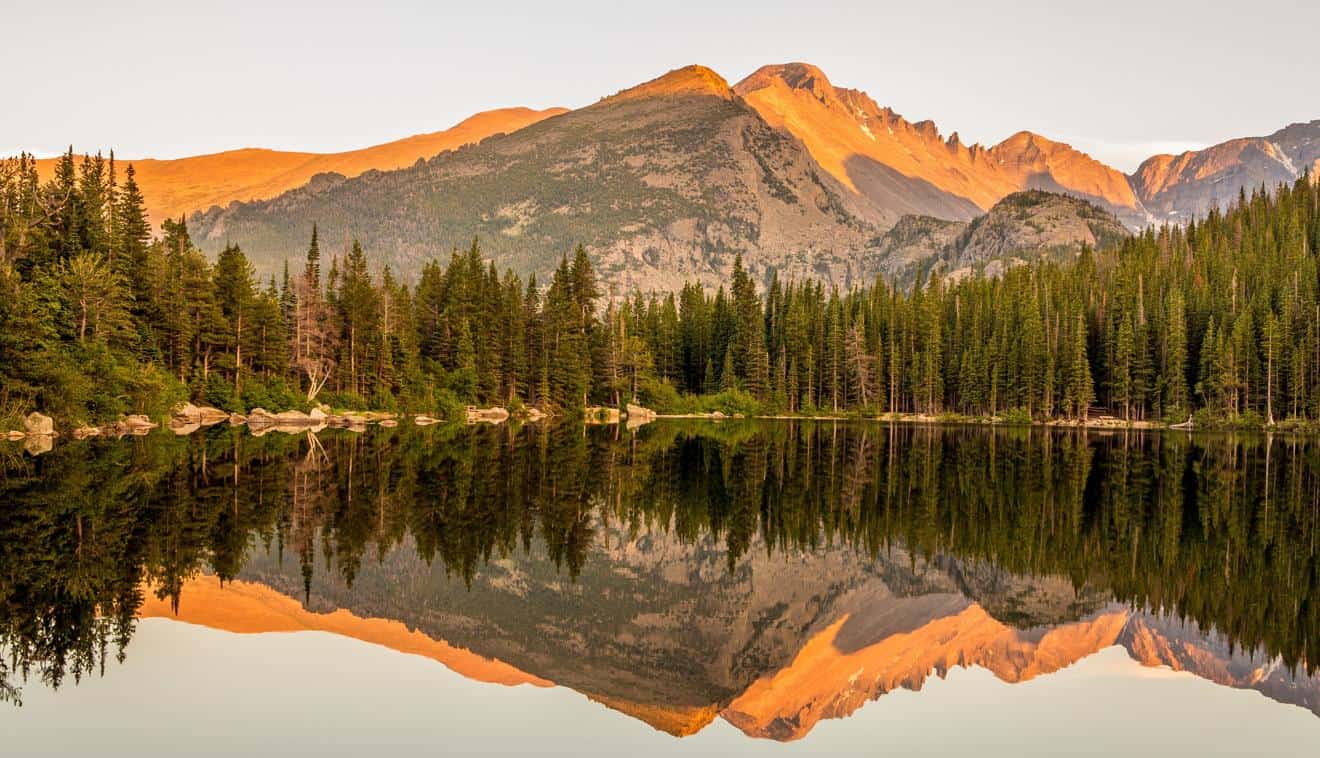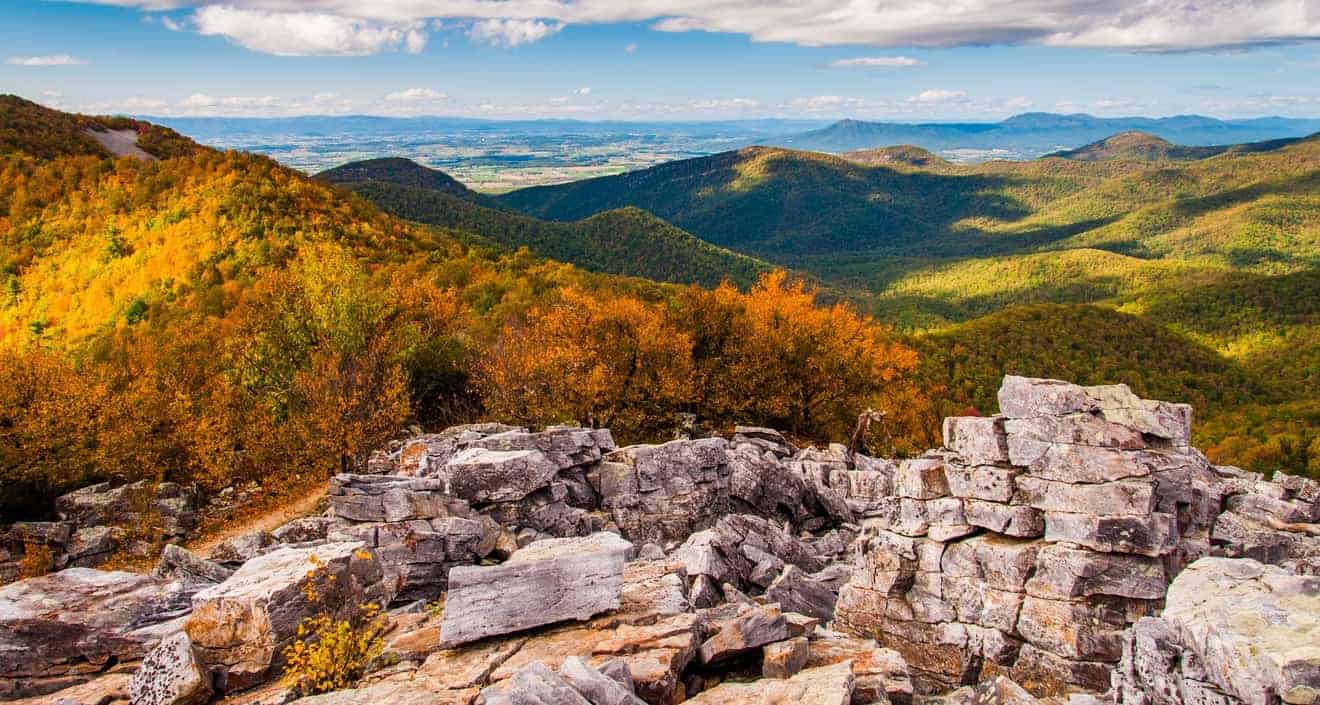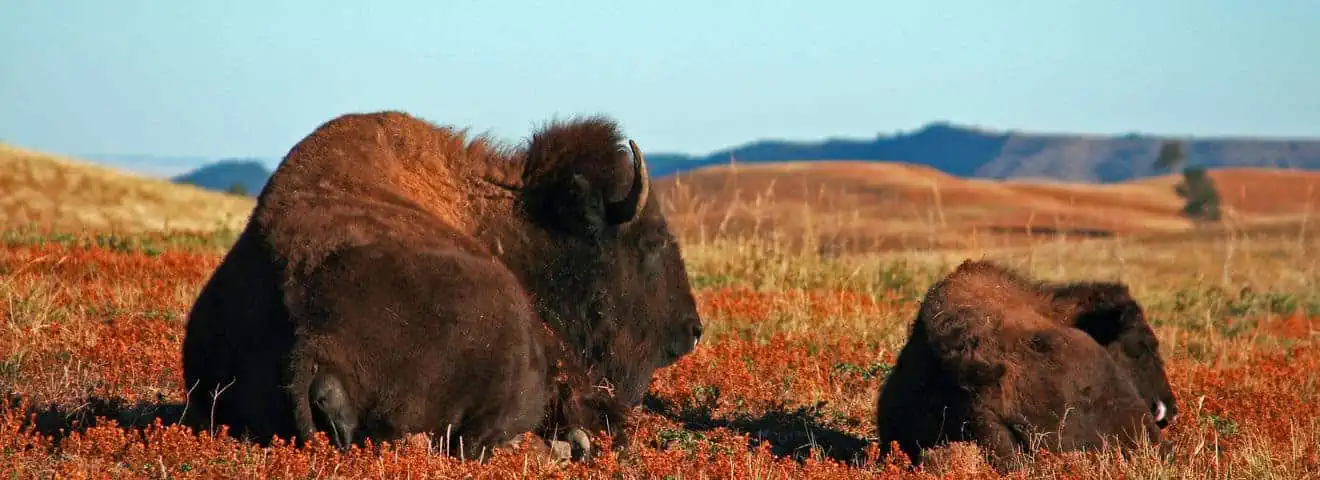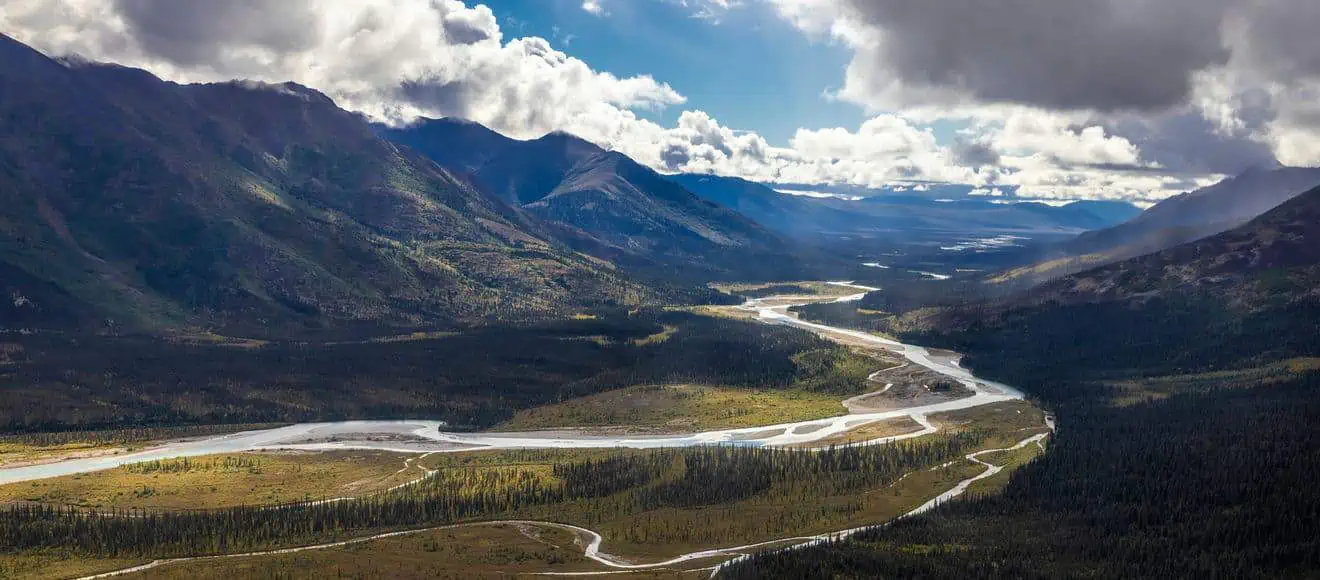Rocky Mountain National Park is one of the most popular, largest and most appreciated parks in the United States. To give you a figure to help you understand the extent we are talking about, there are more than 100 mountain peaks that you can explore. Its location near the city of Denver also makes it an easy stop on a Great American West itinerary.
Even if you are in the area at the peak of the summer season, don’t worry too much because, as we will see, there are many ways to visit the park without getting stuck in traffic or having to wait for hours for a parking space. Lovers of mountain scenery, get ready to discover what are the best things to do in Rocky Mountain National Park.
Contents
Directions to Rocky Mountain National Park
Rocky Mountain National Park is located in Colorado and is open every day of the year 24 hours a day. The most important city nearby is definitely Denver, from where you can reach the east entrance of the park near the Beaver Meadows Visitor Center in less than an hour and a half by car (city traffic permitting). The closest town to the same area is Estes Park, the starting point for the shuttle service to visit the park, as we will see in more detail in the relevant section. If you want to visit the western part of the park, consider the Kawuneeche Visitor Center, 5 minutes by car from the city center of Grand Lake.
Given the size, there are seven visitor centers scattered throughout the park:
- Beaver Meadows Visitor Center: the main visitor center, open every day of the year (except Christmas and Thanksgiving). Here you can watch an approximately 20-minute documentary on the history of the park, as well as find maps and all the information you need for your visit. The opening hours vary depending on the time of year, so check the official website.
- Alpine Visitor Center: as you can guess from the name, this is the visitor center located at the highest point of the park, at more than 11500 feet above sea level. It is open from Memorial Day until October 8 from 9:00 am to 5:00 pm, while it is closed from fall to spring.
- Fall River Visitor Center: periodically, there are exhibitions here that illustrate the variety of fauna and flora of the area including life-size sculptures. It is open from summer to spring, while during the winter months opening times are limited to the days around major holidays.
- Kawuneeche Visitor Center: located just north of the town of Grand Lake, this is the main information point for those visiting the western part of the national park, which is why it is open all year round with hours that vary depending on the season.
- Moraine Park Discovery Center: This is located along scenic Bear Lake Road and is closed during the winter months. There are trails nearby that provide beautiful views of the Moraine Park area. Closed late summer through spring.
- Sheep Lakes Information Station: The area around this visitor center is great for viewing many animals in the wild including the famous Rocky Mountain Sheep.
- Holzwarth Historic Site: More than a visitor’s center, this is a reconstruction of a 1920s ranch where you can learn what life was like for a settler in this wild part of the United States. The inside of the buildings can only be visited during the summer months while throughout the rest of the year the area can still be explored from the outside.
The cost of admission is $30 per vehicle for one day or $35 valid for an entire week (25$ 1 day or 30$ 1 week for motorcycles), otherwise you can use America the Beautiful parks pass. Timed Entry Reservations will be required to enter the park between May 26 and October 22. More information on this can be found in our article dedicated to American parks that require reservations.
Rocky Mountain National Park Shuttle
As mentioned, there are also shuttle services that will allow you to visit a part of the park. There are three buses to choose from and, as far as periods and times of service are concerned, the information below is correct at the time writing this article, so for safety please check the dedicated page on the official website.
- Hiker Shuttle ExpressRoute: the most popular and frequented shuttle. From May 25 to September 13, the service is daily, while from September 14 to October 20, it runs only on weekends. As the name implies, it is an express service that runs from the Estes Park Visitor Center to the large parking area called Park & Ride near the Glacier Basin Campground. The frequency of the rides is as follows:
- one ride every hour from 7:30 a.m. to 10:00 a.m. and from 6:00 p.m. to 8:00 p.m
- one ride every half hour from 10:00 am to 6:00 pm
- Bear Lake Route: daily service from May 25 to October 20. Frequency is very good as you will find a ride every 10-15 minutes from 7:00 am to 7:30 pm. From the Park & Ride area, it will take you up to Bear Lake with stops at the trailhead of the Bierstadt Lake Trailhead and Glacier Gorge Trailhead.
- Moraine Park Route: this shuttle service also operates at the same time as the previous one. Frequency is one ride every 30 minutes from 7:00 am to 7:30 pm. From the usual Park & Ride area it reaches Fern Lake with the following intermediate stops: Sprague Lake – Glacier Creek Stables, Hollowell Park, Tuxedo Park, Moraine Park Campground, C Loop Cub Lake Trailhead.
Using these shuttle services can be very useful both so you can rest a little from driving, and so you have no problems in parking the car to access the most famous areas of the park (such as Bear Lake), which during the high season is very busy, with many people filling the streets and dedicated parking lots. Rocky Mountain is in fact one of the most popular American national parks, visited every year by about four and a half million people, the vast majority of whom flock to the east side.
If you are wondering if there is also such a service for the western part of the park along the scenic Trail Ridge Road, unfortunately, the answer is no.
Best Time to Visit Rocky Mountain National Park
It’s going to be cold, be aware, for much of the year. Prepare yourself well and bring suitable clothing if you want to visit the park not only from inside your car. In winter, the higher you go up in altitude, the colder the temperatures. It’s not uncommon, especially in the Grand Lake area, to reach temperatures of 3,2°F in January and February, and at the Alpine Visitor Center you can even record highs of 17°F and lows of -0,4°F. In the east area of the park, the snow is less deep but the winds are more intense, on the contrary in the west area the snow cover is much deeper but the winds are calmer.
Spring begins to arrive even at high altitudes generally in June, since in April and May further snowfalls are not uncommon. This is an important season because, barring exceptional events, the Trail Ridge Road reopens to traffic in late May.
During the summer the temperatures are mild even at high altitudes, pay attention to the high temperature range between day and night, and to the violent storms that can occur during these months. July will be the hottest month, but consider that it will rarely exceed 77°F in the Estes Park area, while near the Alpine Visitor Center the lows will still be around 32°F and the highs no more than 60-62°F.
You may still find remnants of unmelted snow in the shaded areas at high elevations. Generally speaking, the weather you will encounter will be sunny mornings, afternoons with probable thunderstorms and clear, cold nights. So be sure to bring suitable clothing that can cope with three different types of weather on the same day.
In autumn the temperatures begin to drop again, although the days for the most part remain clear and dry, especially in September and the first half of October. This is also the time when, unfortunately, the Trail Ridge Road is closed to traffic.
Things to Do at Rocky Mountain State Park
Like all American national parks, the main attractions are represented by the scenic roads and trails that can be taken surrounded by nature.
Scenic Drives
There are mainly three scenic drives that will allow you to enjoy beautiful views even if you do not want to walk any of the many paths available on foot. As you can imagine, there are some recommendations to bear in mind. The higher you go up in altitude, the more the temperatures decrease, the air becomes thinner and the sun’s rays are more intense, so make sure you take the necessary precautions.
- Old Fall River Road: opened in 1920, this was the first road built within the park following the ancient trail that the Native Americans who lived in this area used to travel. The road is largely unpaved and covered with gravel but, given its small size, at least it is one-way. There are about 9 miles from Horseshoe Park to Fall River Pass at an altitude of almost 11800 feet, before joining the Trail Ridge Road. Generally it is closed to traffic from October 1st until July and it can only be traveled on foot.
- Trail Ridge Road: this is the highest-elevation paved road in the United States and connects Estes Park with the west side of Grand Lake. It is more than 50 miles of switchbacks, scenic overlooks and breathtaking scenery. It is generally open to traffic from Memorial Day (last Monday in May) until Labor Day (first Monday in September). You’ll travel more than 10 miles above the so-called Tree Line, which is the point beyond which the climate is too harsh for vegetation to grow. The Alpine Visitor Center is reached by taking this road.
- Bear Lake Road: after Trail Ridge Road, it is the most popular road both for its beauty and because it connects the Beaver Meadows Visitor Center to the Bear Lake area which, as mentioned, is one of the most frequented by tourists (during the summer months it is therefore recommended to use the shuttle service). Along the route you will also find the connection to another popular lake: Sprague Lake. During the winter it is only passable thanks to the work of snowplows, and is only closed in cases of very heavy rainfall.


Hiking Trails
Given the width of the park, there are dozens of trails that you can walk. Here I’ll just point out the main ones divided by zones but, if you have time available, get a map at one of the many visitor centers where all the available trails will be marked.
Bear Lake area
As mentioned this is one of the most popular and busy areas of the park, if you go in high season you should use the shuttle service or start out very early, otherwise you risk finding all the parking lots already full. Here is a selection of the most popular routes in this area:
- Bear Lake Loop: circumnavigate the lake with this scenic route of about 0.6 miles in length, It is very easy and undemanding, suitable for almost everyone and will allow you to take beautiful photos of the lake surrounded by trees and mountains, which in winter take on a very special charm.
- Emerald Lake Trail: one of the most beautiful walks that you can take in the park. It also has the merit of being quite easy since it is about 3 miles as a round trip without excessive changes in altitude. From Bear Lake it will take you to Emerald Lake, passing by two other smaller but no less fascinating lakes, Nymph Lake and Dream Lake.
- Alberta Falls Trail: If you want to see small but scenic waterfalls while walking on a pleasant trail surrounded by trees, this trail is for you. It is about two and a half miles to walk, which makes it suitable for just about everyone.
- Flattop Mountain Trail: More than 8 miles as a round trip and almost 2800 feet of elevation gain. This is where things get tricky. The trail is only suitable for the well-trained, but the views you’re going to see are going to be worth all the effort. You will literally be walking on the back of the mountain and you will be able to see the peaks and valleys below you.
Grand Lake area
We are in the western part of the park dominated by a large lake of the same name. It is the coldest area and less frequented by tourists, although it can also offer glimpses of rare beauty.
- Adam Falls Trail: The most popular trail in this area, it is short and easy to hike (just over a mile round trip). You’ll hike through the forest along the course of the river until you reach the waterfalls from which this trail takes its name.
- Cascade Falls Trail: another 3.5 mile one-way trail that runs partly through a valley and partly through the forest (chances of encountering local wildlife are excellent). Following the course of a river you will be able to admire other small waterfalls. The difference in height is about 600 feet, which, combined with the distance to be covered, make it a trail not recommended for those who have little time available.
- East Inlet Trailhead: this long trail connects Grand Lake with Spirit Lake (7.5 miles), also touching other lakes such as Lake Verna along the way (6 miles) and Lone Pine Lake (5 miles). The distances are listed are one-way so our advice is to choose the trail according to your abilities and needs.
Alpine Visitor Center Area
Here are some recommended routes if you want to explore the areas around the popular visitor center.
- Alpine Ridge Trail: This short one-mile round-trip trail takes you up a flight of steps to a headland from where you can see the peaks of the surrounding mountain ranges. Due to its simplicity and convenient location, it is one of the most popular trails during the summer season.
- Irene Lake Trail: This short trail leads from a parking area along Trail Ridge Road to a small but scenic lake.
- Mount Ida Trail: this trail is very challenging and recommended only for experienced trekkers, not only because of the distance to be covered (10 miles with about 2200 feet of elevation gain), but also because for most of the route, you will be above the Tree Line, so potentially exposed to weather conditions such as wind, rain and storms (especially during summer afternoons) without the possibility of shelter. The start is from the parking lot near Poudre Lake just under a 10-minute drive from the Alpine Visitor Center. Once you reach the summit of Mount Ida you’ll be treated to a spectacular view that will make it worth the effort.
Visiting Rocky Mountain State Park in Winter
Before visiting Rocky Mountain State Park in winter it is very important, if not essential, to check in advance the state of the roads and trails on the official website in order to avoid nasty surprises.
Even if it may seem strange, some trails are still accessible even in late winter (except for particularly serious weather events). I am especially referring to those that are located in the eastern part of the park at lower altitudes. However, pay attention to the possible presence of icy stretches and don’t walk if you don’t have suitable shoes with you. Here are some recommended routes at this time of year:
- Upper Beaver Meadows Trail: The trailhead is located at the end of Beaver Meadows Road and is a short loop of a little less than 1.2 miles that takes you on a relaxing walk that is partly in a forest and partly in an open valley. There is also a longer version of about four miles.
- Gem Lake Trail: The start of this trail is in the area just north of Estes Park in the parking area of the Lumpy Ridge Trail. The lake is not large but its location with one side where a high rock wall rises, certainly makes it very scenic. The other peculiarity is that this lake has no tributaries but is formed only by collecting water brought by rains and melting snow. It is a 3-mile round trip with a difference in height of 950 feet.
- The Pool: this is a shorter part of the much longer Fern Lake Trail (a little more than 3 miles compared to 6.5). The trail runs along the Big Thompson River until it reaches an area called the Pool which marks the confluence of the Big Thompson River, the Spruce River and the Fern Creek.
In this period, the walks in the park may be better if undertaken with snowshoes or with cross-country skis on the trails, of course, you must have the necessary equipment that can be rented at the stores of Estes Park and Grand Lake.
Rocky Mountain National Park Tours
If you would like to leave your car (or rental car) parked for the day, and take an organized tour of the area, below are some options for you to consider. These are tours departing from major hotels in both Denver and Boulder that will allow you to tour the park in comfort.
- Park Tour from Denver or Boulder
- Rocky Mountain National Park trip from Denver
- Small Group Park Tour from Denver
Places to Stay Near Rocky Mountain NP
Campsites
Despite the size of the park there are no accommodations to sleep inside and the only option to do so, if you have the necessary equipment with you, is to rely on the five campsites:
- Aspenglen Campground
- Glacier Basin Campground
- Longs Peak Campground
- Moraine Park Campground
- Timber Creek Campground
They are only open during the summer season, with different dates. If you are interested, please check on the official website. If, on the other hand, you prefer to stay in more classic accommodations, you’ll have to look for them in the nearby towns of Estes Park and Grand Lake.
Estes Park
This town is the most important starting point for those who want to explore Rocky Mountain National Park because, in addition to being very close to the park, it is also the starting point of the shuttle service that, as mentioned, can be very important especially during the high season.
- Discovery Lodge (800 Big Thompson Avenue): a series of very spacious rooms in American motel style, but in a context where nature is the master. Lots of greenery, a pond and wooden furniture will make your stay very relaxing.
- Murphy’s River Lodge (481 West Elkhorn Avenue): another accommodation immersed in greenery with a river flowing behind the buildings. There is also an indoor pool that you can use to relax after a day of hiking.
- 4 Seasons Inn on Fall River (1130 West Elkhorn Avenue): this hotel is also located near the banks of a river and it is not uncommon to see local wildlife passing by your accommodation. During the summer, it’s ideal to relax on the terrace with the outdoor hot tub.


Find accommodation in Estes Park
Grand Lake
As mentioned above, the town of Grand Lake is the ideal base for those who want to explore the west side of the park. Here are some recommended accommodations for overnight stays:
- Gateway Inn and Conference Center (120 Lake Avenue): a structure reminiscent of classic mountain lodges both outside and inside, with a beautiful terrace from where you can admire the mountain ranges that surround the area.
- Western Riviera Lakeside Lodging (419 Garfield Avenue): this structure is located on the shores of the lake and from the terraces of the rooms you can enjoy beautiful views of the area. There is also a good restaurant inside the facility.
- Spirit Lake Lodge (829 Grand Avenue): classic American motel, simple but well-maintained, with the option to choose a room equipped with a whirlpool tub.


















